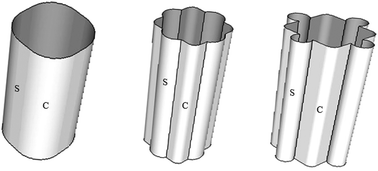We present a mechanical model of the plant cell wall viewed as anisotropic two dimensional soft matter, where a dilute dispersion of cellulose fibrils of variable orientations is uniformly distributed on a curved deformable viscoelastic matrix membrane. The plant cell wall model integrates the elastic energy of the curved membrane, the nematic Landau–de Gennes fiber orientation energy, and competing curvophilic and curvophobic interactions mediated by the membrane geometry and the fibrils' orientation. The selected membrane geometry is a straight cylinder of variable cross-section, whose shape varies from a circle to a sharp super-ellipse as in many cell specimens, and whose size increases as in plant cell wall growth. Model predictions indicate that due to curvature–orientation couplings, the fiber orientation displays three modes: (i) line (along the cylindrical axis), (ii) helical (oblique to the axis), and (iii) ring (normal to the axis), where the former arises under large curvature and the latter under small one. In addition to aligning the fibers in the line mode, high curvature also promotes the order of the fibrils. The predicted fiber structure is validated with fiber structures in the cell wall of tracheids. The structure–property relations for super-elliptical membranes with gradient curvature are established and its role in cell growth shape is predicted. The principal mechanisms are the role of fiber orientation and order on bending stiffness: (a) orientation along the axis has no stiffening effect, (b) orientation along the azimuthal direction produces maximal stiffening, and (c) fiber randomization softens the membrane. The largest fiber stiffening effect is found when the membrane length scale (radius of curvature) and fiber length scale (curvophobic/curvophilic energy ratio) are equal. It is found that super-elliptical shape invariant growth and expansion is preferred for cells with sharp/soft corners and straight/stiff sides. Otherwise growth promotes shape changes. Lastly, master plots that categorize fiber structures by the number of multimodal regimes (line/helix, line/helix/ring) that arise in super-ellipses are used to relate shape and size to domain structures that affect toughness and modulus.

You have access to this article
 Please wait while we load your content...
Something went wrong. Try again?
Please wait while we load your content...
Something went wrong. Try again?


 Please wait while we load your content...
Please wait while we load your content...